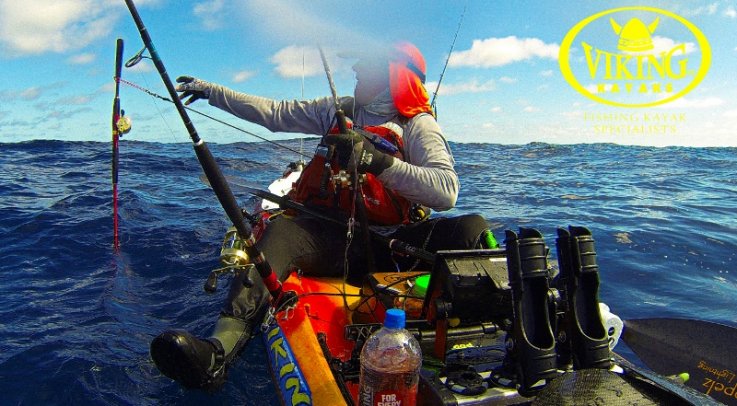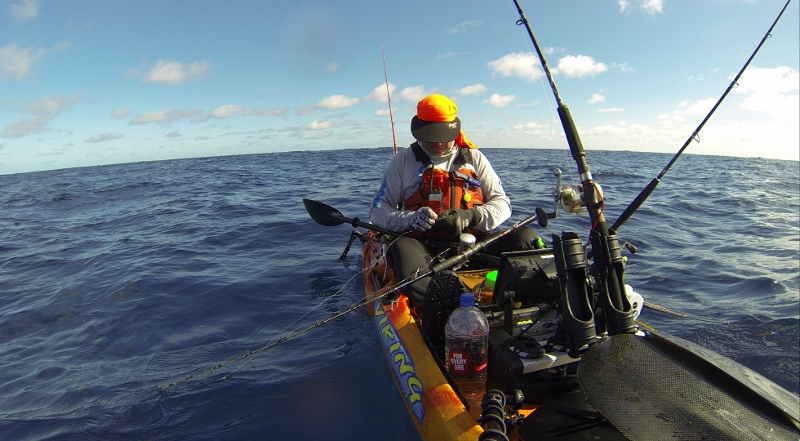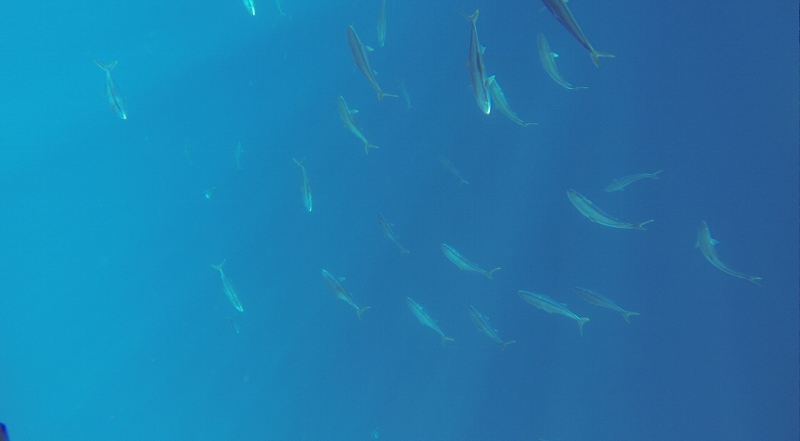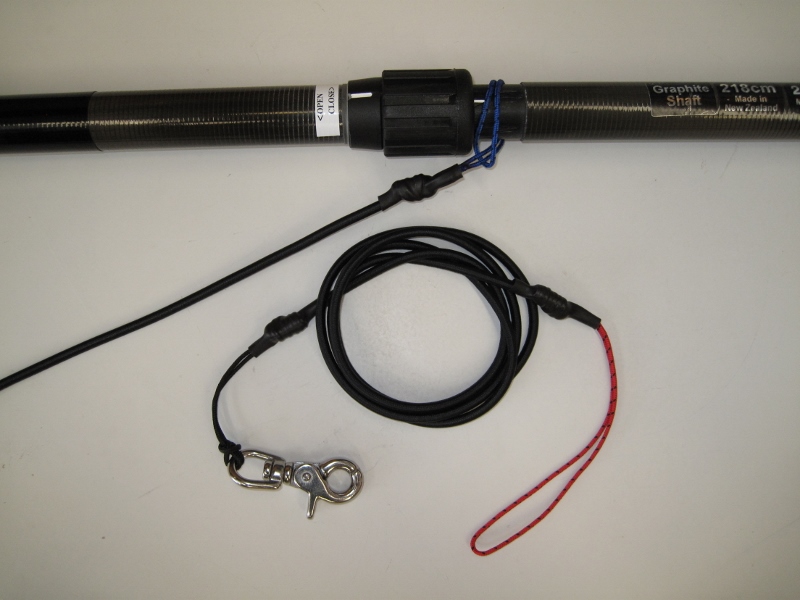Kayak fishing tuna action, Leash up or lose it
1:23AM 2nd Apr 15

Paddle leashes are great bits of gear when things work against you, in this case saving this outfit from heading to the bottom – just be sure you don’t overreach yourself trying to make the save!
Recently I had another hot tuna session off Taranaki successfully boating multiple albacore as reward for the days paddling effort. To add spice on light tackle I even managed to entice a few small kings with trolled lures. At around a meter long they were definitely in another league as their sheer brute power contrasted with the clicker screaming speed of the tuna. The end result was a day of non-stop activity, and by the time I made the beach a collection of blisters and a pair aching arms reminded me of one of the most action packed kayaking sessions I’ve had for a long time!
Given all the fish activity it was inevitable multiple strikes would occur. Normally these aren’t too much of issue as I troll with lures positioned in line astern, and with good separation (typically the rearmost positioned at approximately 40 – 60 paddle strokes behind and the closer lure at half the chosen distance). With a multiple hook-up I find having the closer lure at half the distance to the rearmost allows me to concentrate on the near fish first while the one “way out the back” tends to look after itself. Generally I release the first fish (if it’s in good condition) allowing me to get to the second as fast as possible.
Of course this is making one assumption: the multiple hook-ups are made with fish of the same species, in this case albacore. During this day of high activity I had a totally new kayak trolling experience, an almost simultaneous multiple strike from fish with wildly different fighting styles. Just as an albacore inhaled the rear lure and the ratchet screamed the typical tuna song, a pack of kings mobbed the close lure before could stop paddling and slow the kayak. In a welter of spray one hooked up and my hour of pandemonium had begun!

Re-rigging is one of those times when loosing gear over the side is easy, leash it or lose it!
As mentioned, in a multiple hook-up situation I target the close fish first. Fortunately this meant it was the king I had to do first battle with first, and its deep diving habit would hopefully keep the lines clear as the tuna stayed out back made and ran for the horizon. That said, I did make a silent prayer the albacore would stay on the surface and not plunge into the depths the way the now angry hoodlum was trying to drag me.
Within a few minutes the ratchet on the second line had gone ominously quiet so I attempted to hurry things along as much as possible with the kingfish. Of course this served only to make it even more irate, pushing the 8kg gear to the limit. The ensuing battle saw the kayak being dragged back upwind towards bait ball where all the fun had begun. Just to make it even more interesting the big belly of braid from the second outfit was floating and twitching in the water just a few meters away - the tuna was still attached and also heading back to the bait ball!
At this point crossed lines should have been the inevitable, but with the kingfish fighting deep and the tuna staying near the surface with its mates on the bait, the floating braid stayed clear and problem free – or so I thought! With so much slack line laying off a rod tip that angled back over my head, the one thing I’d forgotten to check was that it hadn’t fouled anything on deck. This lack of attention nearly cost me, but before this the first order of business was to release the now tiring king.
.jpg)
Target specie – the albacore were hungry and I ended up releasing 5 and keeping 5 like this one to feed the troops at home.
This is where hook-out pliers are a God-send to kayak anglers trolling lures rigged with trebles or multiple hooks. As soon as the fish is alongside light tension on the leader allowes me roll the trebles out without even lifting the fish from the water, offering multiple benefits. First and most important is by not lifting the fish on board I’m not risking further harm to it (especially critical it releasing tuna). Leaving the fish in the water for the release also means considerably lessened risk of being pinned by any flailing hooks.
The other big benefit is speed – a boated fish will often give you just long enough floating submissively on the surface to roll the hooks out. Lift them bodily from the water and almost inevitably you have to wrestle them quiet again before getting the hooks out. With tuna I believe this can be the difference between life and death after a battle on light gear. In this multiple hook-up situation a speedy release allows me to move straight to the second rod.

Kingfish were hunting in packs with the tuna, and while not big their power on 8kg gear made for some tough action to contrast the burning tuna runs
With the kingfish released seconds after it was brought alongside I had no time to catch my breath as the other line slammed taught and the albacore made another dash for the horizon. This is when everything suddenly got very dramatic: the rod bucked down, then with a loud “twang” sprang upright again. Out of the corner of my eye I saw a very expensive rod and reel set disappear over the side then lurch back out of the water to be left dangling mid-air!
Horror of horrors while battling the kingfish slack line from the other rod had slipped beneath the reel of my spare sitting in a rear rod holder. When the albacore slammed the line tight again this had catapulted the outfit over the side. Though saved by its leash attaching it to the kayak, the rod and reel were still at risk as the braid now screamed under the shock cord and threatened to cut it.
This is where an escalation could have created all sorts of very real issues, not just a lost rod and reel. Instinct could so easily have seen an angler make a mad grab for the rod (I nearly did but managed to reign myself in just in time – see the attached image). The problem with this is with the fish also pulling in the same direction it would have been incredibly easy to overbalance and end up in the water.
At this point there would be more issues than just the wet, damaged, or lost gear resulting from a roll-over. There are also all the risks associated with being in the water rather than aboard your kayak, the most significant being losing touch with your kayak as the wind blows it out of reach. Fortunately I managed to reign myself in and didn’t go for a swim, but it did serve as a reminder that there are two reasons why I use leashes on paddles and rods.
Leashes aren’t just there to save gear
The first and most obvious reason for a leash is to stop losing important gear – something about the old proverb “being up the creek without a paddle” rings so true when actually sitting on a kayak. Yes, sometimes leashes can be a nuisance when casting, but with most of my rod, reel, and line sets costing closer to $1,000 than $100 any losses would bite the back pocket hard!

Leash systems can take many forms, but they aren’t complicated. Just make sure they’re strong enough to act as a tether if you end up in the water and are relying on it to keep your kayak close.
In addition to saving gear I also consider rod and paddle leashes part of my safety kit. This is something I find many kayak anglers haven’t realised: if you end up in the water the leash attaching the rod or paddle in your hands to your kayak is great at stopping you from becoming separated from your kayak. Whether it’s the wind blowing the kayak away, or a fish on another rod heading for the horizon and leaving you behind, the leash to whatever is in your hand will stop your kayak getting away!
In some situations it may be appropriate for kayak anglers to use personal tethers, but these aren’t without risk and need to be set up correctly with advice from someone experienced in their use. As anglers though, most of our day on the water is spent with either the paddle or a fishing rod in our hands. If these are leashed to the kayak they then become our “safety tethers”, and for most inshore recreational anglers personal tethers aren’t necessary.
For this reason I opt to use rod and paddle leashes all the time. I also make sure they’re up to the task of keeping my kayak close at hand, and aren’t just a light piece of cord or mono to keep attached equipment from Davey Jones’ locker.








